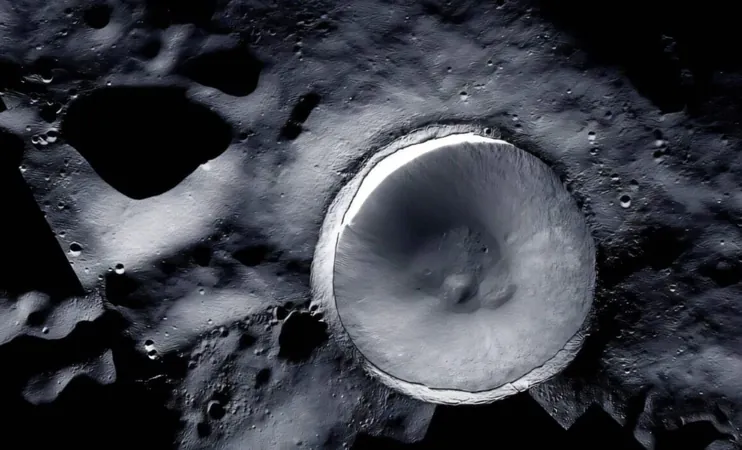
Microbial Mysteries of the Moon: Could Hidden Life Exist in Polar Craters?
2025-04-03
Author: Ling
Microbial Mysteries of the Moon: Could Hidden Life Exist in Polar Craters?
A groundbreaking new study suggests that the Moon’s coldest, darkest regions might hold secrets of ancient microbial life. Researchers have investigated permanently shadowed regions (PSRs) near the lunar poles—craters that have been deprived of sunlight for billions of years—and found that these harsh environments could serve as ideal preservation chambers for microbes. This research was unveiled during the 56th Lunar and Planetary Science Conference (LPSC 2025) and outlined in research abstract #1497.
A Natural Sanctuary for Microbes
The study specifically examined two notable PSRs: Shackleton and Faustini. Known for their extreme temperatures and lack of sunlight, these areas might provide protection against two of the greatest threats to microbial life in outer space: heat and ultraviolet radiation. Dr. John Moores from York University, the lead researcher, stated, “In space, microbes are typically killed by high heat and UV radiation. However, the PSRs are very cold and dark, making them among the most protective environments in the solar system for microbes that are often found aboard spacecraft.”
While microbes within these PSRs may remain dormant—that is, unable to grow or reproduce—their spores and organic remnants could potentially endure for decades or even centuries, preserving biological clues from history.
Concerns for Future Lunar Exploration
NASA’s Artemis program intends to explore these same regions, lured by the discovery of water ice which holds promise for future lunar habitation. However, this creates significant risks regarding microbial contamination—both from previous missions and from astronauts themselves.
“While we can effectively clean robotic spacecraft, human equipment such as spacesuits presents a greater challenge,” cautioned Dr. Moores. “Given that astronauts will likely introduce more contamination into PSRs, any bacteria left behind there could survive far longer than in other lunar environments.”
Such microbial persistence could jeopardize future scientific studies aimed at analyzing lunar ice or organic materials believed to originate from cosmic events like comet and asteroid impacts.
Preserving the Integrity of the Moon’s Shadows
Although safeguarding the PSRs is not a strict planetary protection issue (the Moon does not harbor native life), researchers highlight the necessity of maintaining the scientific purity of these regions. Dr. Moores posed an important question: “To what extent does this contamination matter? Minimizing terrestrial contamination will facilitate a clearer analysis.”
These shadowy craters are essential for understanding the early solar system, with subsequent missions likely focusing on trapped molecules to unravel how vital components like water and organic matter were delivered to celestial bodies lacking atmospheres.
Is There Already Life on the Moon?
In an intriguing twist, it’s conceivable that microbial life has already made its way into the PSRs. For instance, spacecraft collisions—such as NASA's LCROSS mission that impacted the Cabeus crater in 2009—may have transported resilient spores capable of surviving the intense conditions of space.
“The probability that there is already terrestrial microbial contamination in the PSRs is low but not nonexistent,” Moores observed. “Several spacecraft have collided with or near these PSRs. If any microbes survived those impacts, they could be widely dispersed across the lunar surface.”
A New Era for Astrobiology and Lunar Studies
Historically perceived as a lifeless body, the Moon may be on the cusp of a transformative re-evaluation thanks to this new research. Its polar regions, once considered desolate cold deserts, might now be viewed as potential time capsules harboring remnants of life. Whether these microbes originated from Earth, other celestial bodies, or are the remnants of ancient cosmic collisions, their existence could fundamentally alter our understanding of lunar science and astrobiology.
Stay tuned as we uncover more about this fascinating possibility of life beyond our planet!





 Brasil (PT)
Brasil (PT)
 Canada (EN)
Canada (EN)
 Chile (ES)
Chile (ES)
 Česko (CS)
Česko (CS)
 대한민국 (KO)
대한민국 (KO)
 España (ES)
España (ES)
 France (FR)
France (FR)
 Hong Kong (EN)
Hong Kong (EN)
 Italia (IT)
Italia (IT)
 日本 (JA)
日本 (JA)
 Magyarország (HU)
Magyarország (HU)
 Norge (NO)
Norge (NO)
 Polska (PL)
Polska (PL)
 Schweiz (DE)
Schweiz (DE)
 Singapore (EN)
Singapore (EN)
 Sverige (SV)
Sverige (SV)
 Suomi (FI)
Suomi (FI)
 Türkiye (TR)
Türkiye (TR)
 الإمارات العربية المتحدة (AR)
الإمارات العربية المتحدة (AR)